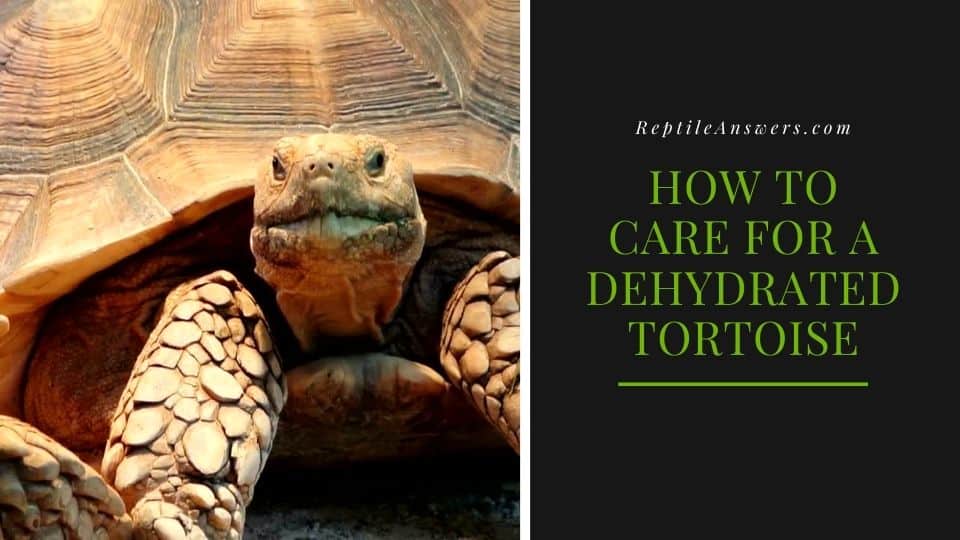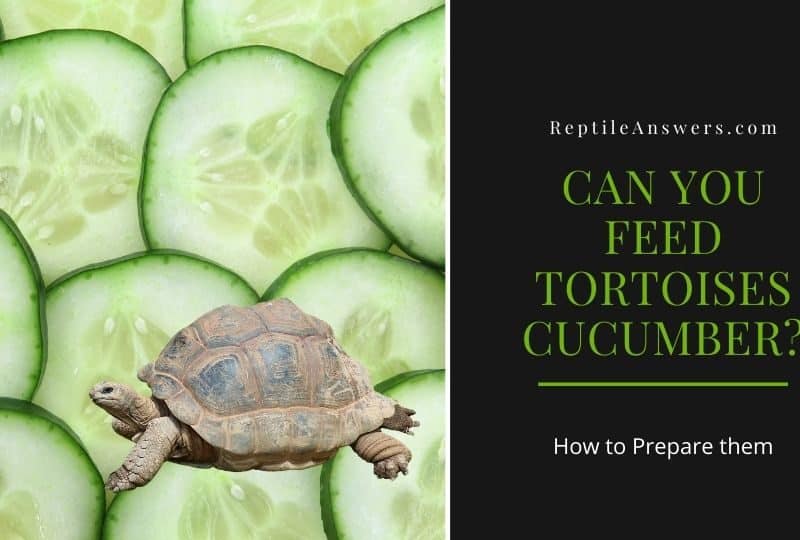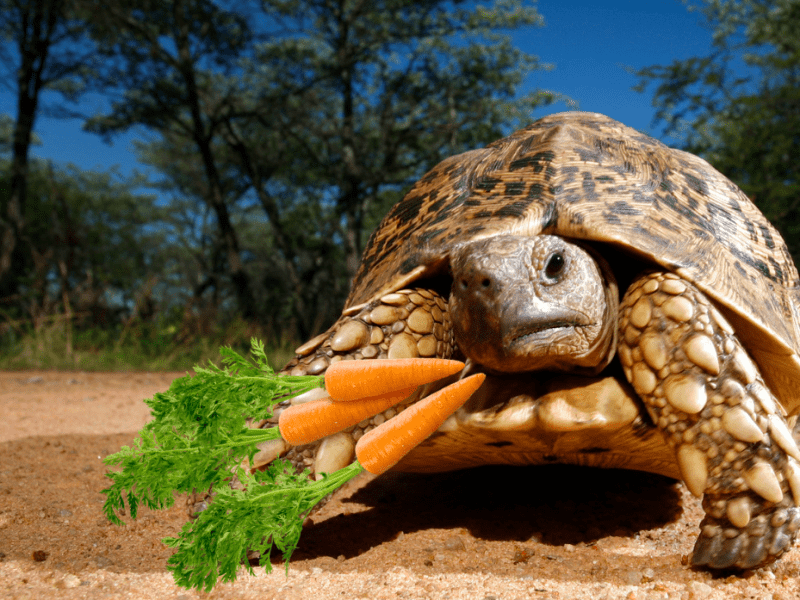Dehydration can cause various health issues and may even kill your pet tortoise if it remains unaddressed. The key is to spot the symptoms of tortoise dehydration, such as sunken eyes, lethargy, and cracking skin.
Here’s how to help a dehydrated tortoise:
Increase the tank’s humidity by misting it regularly and using a humidity gaugeOffer food with high water content, such as lettuce and melonProvide access to clean water and offer electrolyte solutionsAllow the the tortoise absorb water through its cloaca and skin through a bath soak
Tortoises can survive for up to 1 week without water, but they experience complications after about 2 days. A tortoise may die from dehydration in as little as a day, depending on its species and environment. That makes it important to understand when your tortoise is drinking water and if it needs assistance.

How Long Can Tortoises Survive Without Water?
According to the Movement Ecology Journal, tortoises are known to withstand harsh and arid environments. While it’s not ideal for tortoises to go without water for long periods, sometimes they have no choice in the wild. The amount of time a tortoise can survive with no water depends on the following:
Tortoise speciesSurrounding temperatureHumidity levelWater that was drank previously
In a low humidity environment, a tortoise can go without fresh drinking water for a maximum of 1 week. Anything longer than 2 days makes things difficult for a tortoise, as it should take in fresh drinking water every day.
Unfortunately, some owners assume that tortoises can live a long time without food or water because they’re able to live in difficult environments. In truth, tortoises are more likely to achieve their long lifespans if they’re provided with adequate water daily.
How To Tell If A Tortoise Is Drinking Water
Tortoises drink water through their mouths by doing the following:
Stretches out its neckLowers its headPlaces its nose at the bottom of its water bowl
Why Is My Tortoise Not Drinking?
If your tortoise is eating, it may avoid drinking water because it’s getting sufficiently hydrated from its meals. That’s especially true if you serve melons, misted greens, and grazing plants with residual water on them.
If so, give it a regular soak once or twice a week. However, if your tortoise isn’t eating normally and not drinking enough water, you should immediately take it to a vet.
Signs of a Dehydrated Tortoise
Dehydration can lead to problems such as:
Digestive issues
Chemical imbalances
Bladder stones
Skeletal and shell concerns
You may have never seen your tortoise drink and are wondering if it’s dehydrated. Tortoises often glean their water from food and soaks. However, if you notice these symptoms, you should intervene:
Closed or Sunken Eyes
Closed or sunken eyes are the most evident signs of dehydration in pet tortoises. A severely dehydrated tortoise may even develop dimpled corneas.
This symptom may further complicate hydration efforts. Your pet tortoise might not forage for water or soak in its water dish voluntarily since it feels ill.
If your tortoise has closed or sunken eyes, your tortoise needs immediate hydration and could require follow-up care to treat any damage to its eyes or organs.
Reduced Body Weight
A significant part of a healthy tortoise’s body mass is the weight of water present in its tissues. A dehydrated tortoise lacks an appropriate amount of water and will feel light when you hold it.
Pay attention if your tortoise appears to have lost weight. This may not be physically obvious but notable when you pick it up. For smaller tortoises, weight loss can be dangerous when it’s progressed this far.
By monitoring the weight of your tortoise with a scale, you can recognize dehydration while it’s in the early stages.
Poor Muscle Tone
Dehydration causes fatigue for tortoises as well. They lose their strength as they lose water from their bodies. This leads to poor muscle tone.
You can test your tortoise’s muscle tone by pulling gently on its leg. Most tortoises will withdraw their legs quickly into their shell. If your tortoise doesn’t withdraw or does so sluggishly, take it to a vet.

Lethargy/Lack of Motion
If you notice your tortoise isn’t moving around, exploring, or foraging for long periods of time, this is a red flag. Tortoises that rest for abnormally long periods and seem lethargic may be dehydrated.
To encourage your tortoise to move around, eat and drink, you can mist its enclosure heavily. If this doesn’t work, start a soaking routine immediately and get in touch with your vet.
Wrinkled and Dry Skin
Though most tortoises have inherently rough skin, it must lie smoothly against their muscles (except in creased areas, like the inside of the elbow). To test this out, pinch the skin of your tortoise gently.
If it slides back into position quickly, your pet is adequately hydrated. If the skin does not move back into place or moves slowly, your tortoise is most likely dehydrated. A dehydrated tortoise’s skin will also be more puckered, dry, and wrinkled than usual.
How To Treat a Dehydrated Tortoise
Depending on how dehydrated your tortoise is, you may be able to rehydrate it at home. With a few changes to its environment, you can help it feel better within a few days. Here’s how:
Raise the Humidity Level
If the humidity ranges of your tortoise’s enclosure are unbalanced, this can lead to dehydration. You can also help a tortoise with a low thirst drive absorb more water by raising the humidity levels.
To do so, buy a humidity gauge for the enclosure. Close up the tank so that it can hold the environmental changes more effectively. Then, mist your tortoise’s enclosure, gradually increasing the water content in the air.
Moisture-Rich Foods
Your tortoise’s food should consist of misted leafy greens, melons, and soaked vegetables. Greens which have high water content naturally are ideal, such as lettuce. Since tortoises get more water from their food than drinking, focusing on this part of the diet will help rehydrate your tortoise.
Electrolyte Solution
Electrolyte solutions regulate and control the balance of fluids in the body. They are highly beneficial for dehydrated tortoises. To make the electrolyte solution, you will need:
1 part iodized table salt (containing sodium chloride and iodine only)1 part of potassium salt (potassium chloride)1 part baking soda (sodium bicarbonate)12 parts sugar (any pure sugar will do, but please do not use a sugar substitute like stevia, as they are not suitable for tortoises)
Add vitamins, minerals, calcium, fruits, and vegetables to the electrolyte solution. This will make it more palatable and add flavor. It’s especially important if your tortoise has deficiencies in any of these essential nutrients.
Once you mix all the ingredients mentioned above, you will have the electrolyte powder. You can dissolve this powder in water before you give it to your tortoise.
Once you mix this solution with water, it has a shelf-life. You should not keep it in the refrigerator for more than 24 hours. Otherwise, bacteria and mold will begin to grow. Mix the electrolyte powder with water in the following ratios:
1 cup of water with 1 heaped tablespoon of the electrolyte powder1 liter of water with 2.5 heaped tablespoons of the electrolyte powder1 gallon of water with 2/3rds of a cup of the electrolyte powder
Water Soak
Tortoises not only drink water but absorb it through baths or “soaks.”
According to the Journal of Fish and Wildlife Management, tortoises use the skin around the cloaca located in their tail to absorb water. This is why soaking them helps to improve hydration. It also keeps them strong and healthy, warding off bacteria that attach to the body.
Tortoises also need frequent soaks to prevent their skin and shell from cracking due to dryness. A low humidity environment is good for mammals because it keeps us dry. However, that’s far from helpful to reptiles. Without enough water in the air, their skin and scales will dry out quickly. Only some species are designed to thrive in arid environments, like the desert tortoise.
As well as absorbing water, tortoises like to drink water from their bathing container while you’re giving them a soak. To boost your pet’s fluid and hydration levels, consider soaking it in the electrolyte solution you’ve prepared, rather than just plain water.
How To Soak A Tortoise
Most tortoises are cooperative during baths and even enjoy them. Here are 5 steps for soaking a tortoise:
Fill a Container
Ensure that your tortoise’s bathing area is large enough for it to move around. The edges should be too high for your pet to climb out.
Use lukewarm water for the soak. It should not be hot. If the temperature is too severe, add cold water or wait for it to cool down before introducing your tortoise. If the water is too hot, it will dry out your pet’s skin. Depending on the temperature, it may also be painful.
Likewise, cold water can make your tortoise lethargic and upset its digestion. Aim for a balance of the two.
Soak Your Tortoise
Introduce your tortoise to the container once the water reaches the optimum temperature. Ensure the water levels do not go above your tortoise’s head. Tortoises can’t swim or tread water, so it’s dangerous to fill the container too full.
At this point, allow your tortoise to wander about in the water. Its body will rehydrate naturally without requiring any input from you.
Unfortunately, most tortoises poop when they get wet, especially in lukewarm water. However, this is nothing to worry about. If this happens, empty the water and replace it as soon as your tortoise poops. This will prevent your tortoise from getting infected due to the dirty water inside the container.
Let Your Tortoise Rehydrate
Allow 20-30 minutes for your tortoise to rehydrate in the bath. It will need some time to soak to rehydrate effectively. You’ll know your tortoise is ready because it will try to climb out of the bath all by itself. Pick it up gently and lift it from the container once it’s done.
Dry Down
No matter how much hydration your tortoise needs, you should never send it back to its enclosure while still wet. This will cause your tortoise to grow cold or damp, inviting illnesses and respiratory infections.
Take a towel and gently pat your tortoise dry. Make sure you pat down all the edges of the shell and around the tops of its head, arms, and legs. To maintain good hygiene, wash the used towel separately from any towel that you use.
Water Disposal
You should not reuse the same bath water on your newly soaked pet or any other animal. Pet tortoises carry the salmonella bacteria, which can cause food poisoning in human beings that can be serious enough to kill.
Therefore, you should never pour the bathwater down the kitchen sink or anywhere you would wash your face. Pour the dirty bathwater directly into a drain or down the toilet. Flush immediately if you use the toilet, and then add a little bleach for the sake of good hygiene.
Ensure that the depth of the water inside the bowl is just below your pet’s bottom jaw. Fortunately, it’s easy to keep your tortoise hydrated, as it gets most of its water from its regular diet and water baths.



